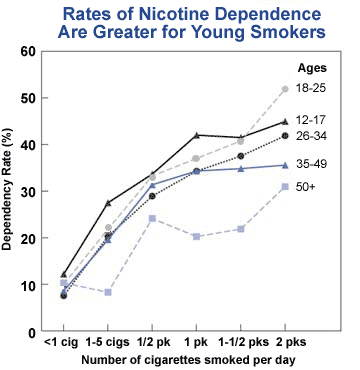Adolescents, Women, and Whites More Vulnerable Than Others to Becoming Nicotine Dependent
Download PDF Version What is PDF?
Patrick Zickler
Patrick Zickler is a Staff Writer for NIDA NOTES.
Source: NIDA NOTES, Vol. 16, No. 2, May, 2001
Public Domain
Table of Contents (TOC)
Article: Adolescents, Women, and Whites More Vulnerable Than Others to Becoming Nicotine DependentReferences
Rates of drug dependence — the percentage of users who experience symptoms that reinforce their drug use and have trouble quitting — are higher for nicotine than for marijuana, cocaine, or alcohol. Rates of dependence also vary among different groups of smokers, according to NIDA-supported research. A new study suggests that differences in sensitivity to nicotine make some smokers more likely than others to develop nicotine dependence. Age, sex, and race all appear to make a difference.
Dr. Denise Kandel and Dr. Kevin Chen of Columbia University in New York City analyzed data collected between 1991 and 1993 as part of the National Household Survey of Drug Abuse, which surveys a representative sample of the U.S. population 12 years and older. In examining data from 22,292 respondents who had smoked cigarettes during the preceding month, Dr. Kandel and her colleagues determined rates of nicotine dependence symptoms based on respondents’ reports of tolerance (needing to smoke more to feel the effects), withdrawal symptoms, smoking more than intended, failed efforts to cut down, negative social and job-related consequences, and persistent health problems.

Data from the National Household Survey on Drug Abuse show that the rate of nicotine dependence is higher in people younger than 25 than in other age groups and that the dependence develops with less exposure to nicotine.
The researchers found that among persons who smoke one-half pack of cigarettes each day, nicotine dependence rates are higher among females than males (31.6 percent compared with 27.4 percent) and higher among whites (31.3 percent) than among blacks (25 percent) and Hispanics (27.6 percent). Adolescents smoke fewer cigarettes than adults but experience significantly higher rates of dependence than adults at the same level of use. Dependence rates are lowest among adults older than 50. Overall, the researchers say, dependence rates increase sharply as consumption moves up to 10 cigarettes per day. The rates level off with higher consumption, although dependent smokers need to smoke more to feel the physical effects of nicotine.
 "Understanding the differences among groups in their vulnerability
to developing nicotine dependence will be valuable in developing
targeted strategies for prevention," Dr. Kandel says. "The
higher rates at which adolescent, women, and white smokers
develop symptoms of nicotine dependence given the same quantity
smoked daily seem to reflect differences in sensitivity
to nicotine. Increased sensitivity may also account for
the fact that adolescents develop symptoms of dependence
at lower doses of nicotine than adults."
"Understanding the differences among groups in their vulnerability
to developing nicotine dependence will be valuable in developing
targeted strategies for prevention," Dr. Kandel says. "The
higher rates at which adolescent, women, and white smokers
develop symptoms of nicotine dependence given the same quantity
smoked daily seem to reflect differences in sensitivity
to nicotine. Increased sensitivity may also account for
the fact that adolescents develop symptoms of dependence
at lower doses of nicotine than adults."
Adolescents appear to be particularly vulnerable to becoming nicotine dependent, especially at low levels of cigarette consumption and when they continue to smoke on a regular daily basis, according to the researchers. Adolescents’ nicotine dependence rates were associated with the length of time that they had been daily smokers, in contrast with adults, in whom dependence rates were associated with the amount of tobacco smoked. "Once regular smoking has been established, quantity smoked may become a more important determinant of dependence than duration of daily smoking," Dr. Kandel says. "This possible connection suggests that with adolescents we should focus not only on preventing the uptake of smoking but on shortening smoking careers as soon as possible."
Kandel, D.B., and Chen, K. Extent of smoking and nicotine dependence in the United States: 1991-1993. Nicotine and Tobacco Research 2(3):263-274, 2000.


